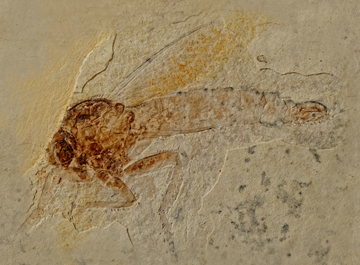Abstract
The parasitic wedge-shaped beetle Ripidinelia burmiticola gen. nov. et sp. nov. (Coleoptera: Ripiphoridae: Ripidiinae) is described and illustrated based on a single male inclusion preserved in a mid-Cretaceous amber of Myanmar. The species shows an unique combination of characters, i.e., three-segmented maxillary palpi known for example in another Cretaceous genus Protoripidius Cai, Yin et Huang, 2017 and some extant Australian genera, 11-segmented antennae with three basal antennomeres simple and remaining antennomeres bearing long rami, known for example in extant genus Ripidius Thunberg, 1806 but unique among Cretaceous Ripidiinae, and each tibia armed by one tibial spur. Additional seven males including one double and one triple syninclusions from the same deposit are ascribed to the same genus. The presence of tibial spurs in Ripidinelia gen. nov. requires redefinition of the subfamily Ripidiinae, because tibial spurs were absent in all so far known species of the subfamily.
References
Batelka, J., Engel, M.S., Falin, Z.H. & Prokop, J. (2011) Aggregative behaviour of ripidiine males “frozen” in the fossil record, with the description of two new species in Dominican Amber (Coleoptera: Ripiphoridae). European Journal of Entomology, 108, 275–286.
https://doi.org/10.14411/eje.2011.037
Batelka, J., Prokop, J. & Engel, M.S. (2016) New ripiphorid beetles in mid-Cretaceous amber from Myanmar (Coleoptera: Ripiphoridae): First Pelecotominae and possible Mesozoic aggregative behaviour in male Ripidiinae. Cretaceous Research, 68, 70–78.
https://doi.org/10.1016/j.cretres.2016.08.002
Batelka, J., Engel, M.S. & Prokop, J. (2018) A remarkable diversity of parasitoid beetles in Cretaceous amber, with a summary of the Mesozoic record of Tenebrionoidea. Cretaceous Research, 90, 296–310.
https://doi.org/10.1016/j.cretres.2018.04.019
Batelka, J., Prokop, J., Pohl, H., Bai, M., Zhang, W. & Beutel, R.G. (2019) Highly specialized Cretaceous beetle parasitoids (Ripiphoridae) identified with optimized visualization of microstructures. Systematic Entomology, 44, 396–407.
https://doi.org/10.1111/syen.12331
Besuchet, C. (1956) Biologie, morphologie et systematique des Rhipidius. Mitteilungen der Schweizerischen Entomologischen Gesellschaft, 29, 73–144.
Cai, C.Y., Yin, Z.W. & Huang, D.Y. (2018) A new ripiphorid beetle from Upper Cretaceous Burmese amber sheds light on early evolution of the extant subfamily Ripidiinae (Coleoptera: Ripiphoridae). Comptes Rendus Palevol, 17, 351–356.
https://doi.org/10.1016/j.crpv.2017.12.002
Engel, M.S., Falin, Z.H. & Batelka, J. (2019) A new genus of Pelecotominae from Mexico, with notes on the genera Clinops and Scotoscopus and the description of new species (Coleoptera, Ripiphoridae). ZooKeys, 857, 59–84.
https://doi.org/10.3897/zookeys.857.34938
Falin, Z.H. (2003) Phylogenetic analysis and revision of the genera and subfamilies of the Ripiphoridae (Coleoptera). Unpublished PhD Dissertation, University of Kansas, Lawrence, xxiv + 535 pp.
Falin, Z.H. & Engel, M.S. (2014) Serendipity at the Smithsonian: The 107-year journey of Rhipidocyrtus muiri Falin & Engel, new genus and species (Ripidiinae, Ripidiini), from jungle beast to valid taxon. ZooKeys, 424, 101–116.
https://doi.org/10.3897/zookeys.424.7853
Fedorenko, D.N. (2009) Evolution of the beetle hind wing, with special reference to folding (Insecta, Coleoptera). Golovatch, S.I. (Ed.). Pensoft, Sofia-Moscow, 1–336.
Kaupp, A., Falin, Z. & Nagel, P. (2001) An annotated catalogue of fossil Ripiphoridae, taxonomic notes, and the description of a new genus and species from Baltic amber (Coleoptera: Ripiphoridae: Ripidiinae). Mitteilungen aus dem geologisch-paläontologischen Institut der Universität Hamburg, 85, 165–195.
Kukalová-Peck, J. & Lawrence, J.F. (1993) Evolution of the hind wing in Coleoptera. The Canadian Entomologist, 125, 181–258.
https://doi.org/10.4039/Ent125181-2
Lawrence, J.F., Falin, Z.H. & Ślipiński, A. (2010) Ripiphoridae Gemminger and Harold, 1870 (Gerstaecker, 1855). In: Leschen, R.A.B., Beutel, R.G., Lawrence, J.F. (Vol. Eds.), Coleoptera, Beetles; Volume 2: Morphology and Systematics (Elateroidea, Bostrichiformia, Cucujiformia partim). In: Kristensen, N.P., Beutel, R.G. (Eds.), Handbook of Zoology, Arthropoda: Insecta. Berlin, Walter de Gruyter, pp. 538–548.
https://doi.org/10.1515/9783110911213.538
Riek, E.F. (1955) The Australian rhipidiine parasites of cockroaches (Coleoptera: Rhipiphoridae). Australian Journal of Zoology, 3, 71–94 + pls 1–4.
Selander, R.B. (1957) The systematic position of the genus Nephrites and the phylogenetic relationships of the higher groups of Rhipiphoridae (Coleoptera). Annals of the Entomological Society of America, 50, 88–103.
https://doi.org/10.1093/aesa/50.1.88
Viana, M.J. (1958) Neorrhipidius, nuevo género perteneciente a la tribu Rhipidiini, con tres nuevas especies de Argentina y Paraguay (Coleoptera, Rhipiphoridae). Boletín del Museo Argentino de Ciencias Naturales “Bernardino Rivadavia”, 15, 1–26.

